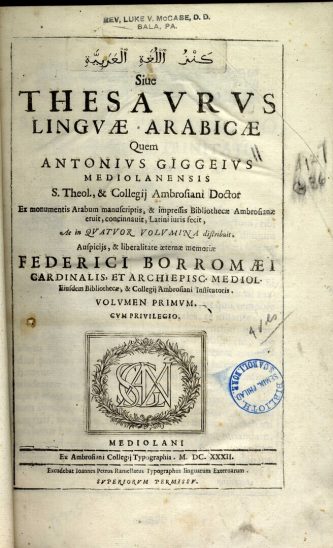Kanz al-Lugga al-’Arabiyya. Thesaurus linguae Arabicae. FOUR VOLUMES.
Giggeo, Antonio,
Synopsis
The first large-scale Arabic-Latin dictionary. This publication was at once the largest in the field of Arabic studies. Not even Golius’s dictionary, published in 1653, could stand comparison. The dictionary was compiled over a period of eighteen years, and its printing took nine years.
Antonio Giggeo, an Orientalist and linguist, composed his thesaurus using the fine collection of Arabic manuscripts in the Bibliotheca Ambrosiana in Milan, Italy, founded in 1607 by Cardinal Federico Borromeo (1564-1631) as one of the first libraries open to the public. Giovanni Pietro Ramellato was one of several printers who worked for the library’s printing-press and this was one of the first books printed by him at the press. In the preface praise is given to Cardinal Federico Borromeo’s heroic efforts to provide the Ambrosian College with printing equipment for Greek, Hebrew, Arabic, Persian and Armenian languages. This dictionary, as opposed to that of Raphelengius, was the first to be based on the works of the Arabic lexicographers themselves. In the preface Giggeo mentions his Arabic sources, the most important being the Qamus of al-Firuzabadi and the Sahah of al-Gauhari. According to Schnurrer (p.51), Giggeo based his work mainly on the former, and Golius on the latter, and this fact, combined with the weight of four unwieldy tomes, would explain why Giggeo’s work was less appreciated and still available in 1811. Golius hardly consulted Giggeo’s work in the preparation of his own dictionary, often to his advantage, as has been shown by Schnurrer. Giggeo’s work was, however, the first Arabic book printed in Milan (Krek, Gazetteer, 65), and in Schnurrer’s index it is the only 17th century one. The Arabic types, a neat 16 pt, are unlike those of Granjon, of Savary, or other types in use at the time in Rome. (Krek, Typographia, 12).
The Ambrosian College took an active part in the study of oriental languages. Rivola published an Armenian-Latin dictionary and grammar (in 1621 and 1624; the first one was republished by Vitaray in 1633), but not much more can be told of its actual publications (De Gubernatis, pp. 218-223).
Bibliographic references: Lambrecht 463 (with an incorrect Arabic title); Fück 79; Schnurrer 64; Smitskamp 226; Zaunmuller 18.






